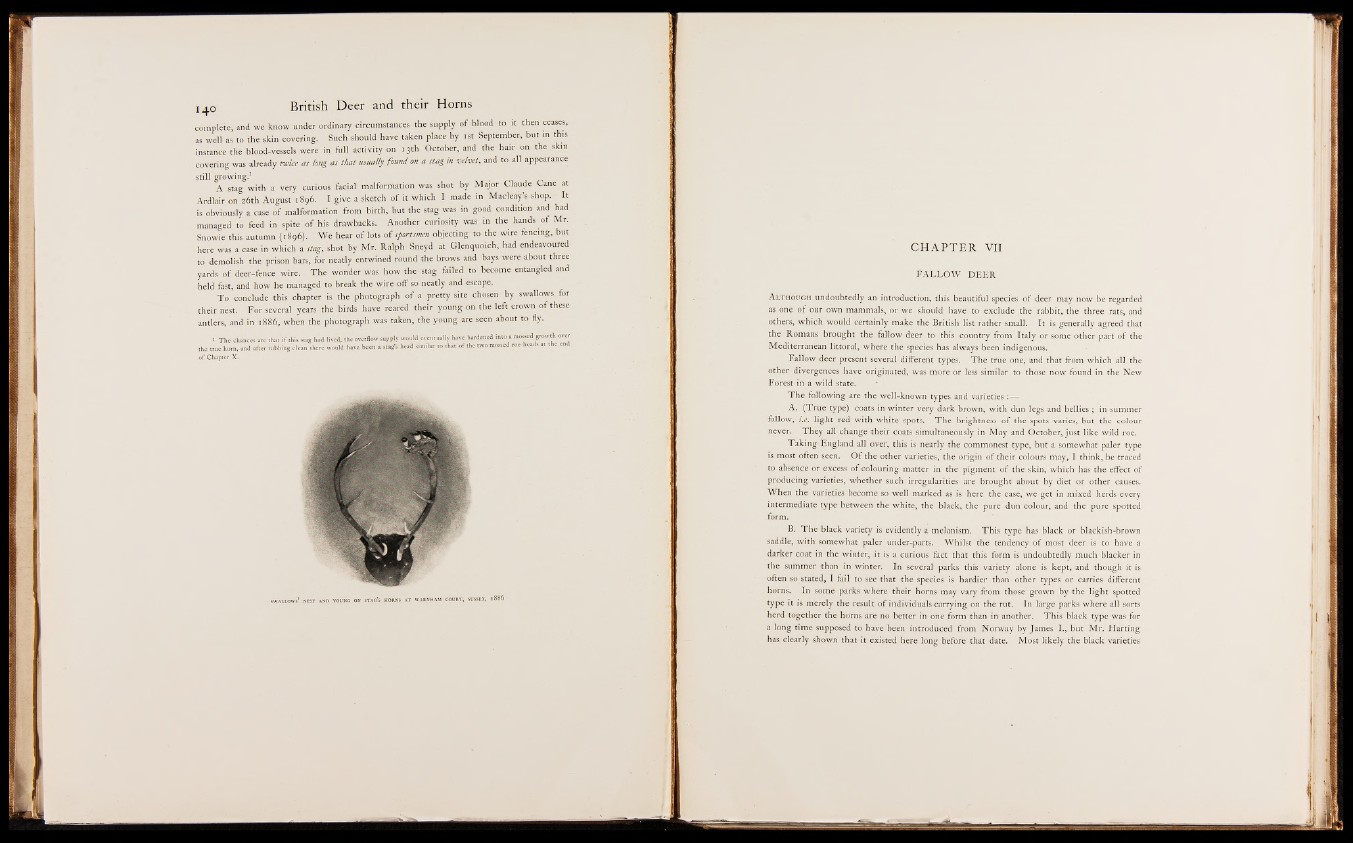
complete, and we know under ordinary circumstanOes the supply o f blood to it then ceases,
as well as to the skin covering. Such should have taken place by tst September, but in this,
instance the blood-vessels were in full activity « 13th October, and the hair on the .skm
covering was already twice as long as that usually found on a-stdg in velvet, and to all appearance
still growing.1 ' . ■
A stag with a very curious facial malformation was shot by Major Claude Cane at
Ardlair on 26th A u gu s t® 96. I give a.sketch o f it which I made in Macleay’s shop. It
:& obviously a case of malformation from birth, but the stag was in gooff condition and had,
managed to feed in spite o f his drawbacks; Another cpSosity was in the hands | | M r.
Snowie this autumn ( i # J | W e hear o f lots o f sportsmen « fe e lin g to the wire fencing, but
here was a case in which a stag, shot by Mr. Ralph Sheyd at Glenquoich, had endeavoured
tp demolish the prison :bVs, for neatly entwined reffnd the brows, and bays were ahopt three
yards o f deer-fence wire. The wonder was. h i » the st|g failed to' hecpme entangled and
held last, and how he managed to break the wire, o ff so neatly and escape.
T o conclude this chapter is the photograph o f,a pretty site chosen by swallowskfor
their nesh For several years the bujpt have reared their young on the leftiqr-own o f these
antlers, and in 1886, when the photograph was taken, the jj§ung are seen about to fly.
1 Thé ditmeli&e that*Sln teg he'd livM.'the overflow ripply would S â t u e ïy hevehndened into a mo ed growth over;
the true .horn, and after rubbing clean there would have be‘en a stag’s head similar to that o f the two mossed roe ea s at t e en
of Chapter X.
t, 1886
CH A P T E R VII
F A L L O W D E E R
A l t h o u g h undoubtedly an introduction, this beautiful species o f deer may now be regarded
as one o f our own mammals, or we should have to exclude the rabbit, the three rats, and
others, which would certainly make the British list rather small. It is generally agreed that
the Romans brought th.e fallow deer to this country from Italy dr some other part o f the
Mediterranean littoral, where the species has always been indigenous.
Fallow deer present several different types. The true one, and that from which all the
other divergences have originated, was more or less similar to those now found in the New
Forest in a wild state.
T h e following are the well-known types and varieties :—
A . (True type) coats in winter very dark brown, with dun legs and bellies ; in summer
fallow, i.e. light red with white spots, T h e brightness o f the spots varies, but the colour
never. T hey all change their coats simultaneously in May and October, just like wild roe.
Taking England all over, this is nearly the commonest type, but a somewhat paler type
is most often seen. O f the other varieties, the origin o f their colours may, I think, be traced
to absence or excess o f colouring matter in the pigment o f the skin, which has the effect of
producing varieties, whether such irregularities are brought about by diet' or other causes.
When the varieties beeoime so well marked as is here the case, we get in mixed herds every
intermediate type between the white, the black, the pure dun colour, and the pure spotted
form.
B. T h e black variety is evidently a melanism. This type has black or blackish-brown
saddle, with somewhat paler under-parts. Whilst the tendency o f most deer is to have a
darker coat in the winter, it is a curious fact that this form is undoubtedly much blacker in
the summer than in winter. In several parks this variety alone is kept, and though it is
often so stated, I fail to see that the species is hardier than other types or carries different
horns. In some parks where their horns may vary from those grown by the light spotted
type it is merely the result o f individuals carrying on the rut. In large parks' where all sorts
herd together the horns are no better in one form than in another. This black type was for
a long time supposed to have been introduced from Norway by James I., but Mr. Harting
has clearly shown that it existed here long before that date. Most likely the black varieties
i